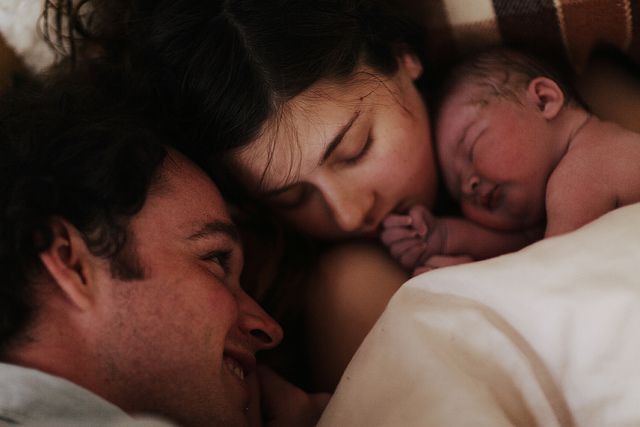
Co-Sleeping: Are You Putting Your Baby at Risk or Doing the Right Thing?
Your little one is finally asleep. You’re lying there, staring at their tiny face, and the question pops up: Should they stay right here beside me, or is the crib the safer choice?
Co-sleeping is one of those parenting topics that sparks endless debate. Some parents swear by the closeness, others worry about the risks. Doctors and researchers, too, often have differing views.
So let’s explore this world together: the science, the stories, and the safety tips that can help you decide what works for your family.
What Exactly is Co-Sleeping?
Co-sleeping simply means your baby sleeps close to you, but it doesn’t always mean the same bed. There are two main versions:
- Bed-sharing: The baby sleeps in the same bed as the parents.
- Room-sharing: The baby sleeps in the same room but on a separate surface, such as a crib or bassinet.
Both practices have benefits and drawbacks, and understanding them can help you make an informed choice for your family.
💡 Parents and doctors often use co-sleeping to mean different things, so it helps to clarify the difference.
Co-Sleeping at a Glance: Pros & Cons
Before diving into the medical advice, it's helpful to consider the bigger picture.
Pros
Co-sleeping can make nighttime routines easier and support both baby and parent. Research shows that sleeping close to a parent can:
- Support breastfeeding, making night feeds more convenient.
- Help regulate a baby’s stress and heart rate, keeping them calm and secure.
- Allow for quicker soothing during night wakings, reducing crying spells.
- Foster emotional security, helping babies feel safe and comforted.
- Let parents monitor their baby’s comfort and health more closely
Cons
- Bed-sharing raises the risk of SIDS (Sudden Infant Death Syndrome) and suffocation
- Babies (and parents) may wake more frequently due to movements, noises, or restlessness, which can affect everyone’s sleep quality.
- Overheating due to close contact, blankets, or high room temperatures.
- Some babies may find it harder to transition to sleeping on their own later as they grow up
So… Is It Really Safe?
Here’s where things get complicated.
What the experts say:
Safety is a key concern, especially for newborns. Singapore’s KK Women’s and Children’s Hospital (KKH) advises against bed-sharing for infants under one year, recommending room-sharing without bed-sharing as the safest setup to reduce the risk of SIDS and other sleep-related incidents. The American Academy of Paediatrics (AAP) echoes this, citing the higher risks of SIDS, accidental suffocation, and overheating.
Even with these warnings, co-sleeping can offer real advantages. It supports breastfeeding, helps regulate a baby’s stress and heart rate, and allows for easier nighttime soothing.
Parents’ Opinions
At the end of the day, co-sleeping is a personal choice, and parents’ experiences show just how different that choice can look. Some parents love the closeness it brings. One shared, “I could nurse half-asleep, and we both woke up happier,” reflecting the calm and comfort of nighttime feeds.
But it isn’t always that simple. As children grow, the cosy nights can turn a little chaotic. One parent joked, “It turned into a nightly karate match with my toddler,” highlighting the sometimes unpredictable reality of sharing a bed.
Other families discover co-sleeping unexpectedly. One admitted, “We didn’t plan on co-sleeping because we were taught/told that it’s unsafe, leads to dependency, etc. But here we are 10 months later with a crib and bassinet we don’t use,” showing how routines often evolve based on the child’s needs.
And for some, co-sleeping simply didn’t work. One parent shared, “Co-sleeping doesn’t work for us and I’m sick of people telling me how terrible sleep training is and how co-sleeping is the best thing for my baby,” reflecting the frustration that can come when it doesn’t meet expectations.
Every story is different, shaped by each child’s personality, the family’s routines, and personal comfort levels. These varied experiences highlight why co-sleeping sparks so much debate: there’s no one-size-fits-all answer, and what works beautifully for one family may be a challenge for another.
Disclaimer: Parents’ opinions shared here have been gathered from publicly available internet sources like Reddit. These are personal experiences and do not replace professional medical guidance. Always consult your paediatrician or healthcare provider before making sleep decisions for your baby.
Final Verdict: Room-Sharing or Bed-Sharing?
Both approaches have their merits:
Room-Sharing:
- Recommended by medical bodies, especially for the first year.
- Reduces risk of SIDS and suffocation.
- Easier to transition the baby to independent sleep later.
Bed-Sharing:
- Supports breastfeeding and night-time soothing.
- Strengthens emotional bonding.
- Offers convenience but comes with increased risks if safety guidelines aren’t followed.
Ultimately, the choice depends on your family’s comfort, the baby’s temperament, and how carefully you can follow safe-sleep guidelines. Even if you opt for bed-sharing occasionally, ensuring a firm mattress, minimal bedding, and keeping the baby dry and comfortable (hello, Cloud Soft Diapers!) goes a long way.
Co-sleeping isn’t inherently good or bad; it’s a personal decision. By understanding the facts, considering expert advice, and learning from other parents’ experiences, you can make the choice that works best for your family. After all, the goal is simple: everyone gets safe, restful, and happy sleep.

